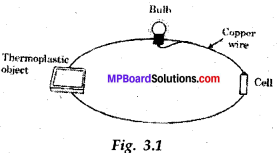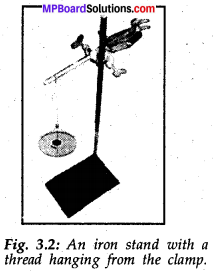In this article, we will share MP Board Class 8th Science Solutions Chapter 3 Synthetic Fibres and Plastics Pdf, These solutions are solved subject experts from the latest edition books.
MP Board Class 8th Science Solutions Chapter 3 Synthetic Fibres and Plastics
MP Board Class 8th Science Synthetic Fibres and Plastics NCERT Textbook Exercises
Mp Board Class 8 Science Solution Chapter 3 Question 1.
Explain why some fibres are called synthetic.
Answer:
All fibres are not natural. Some fibres are man-made. The fibres made artificially are called synthetic fibres.
Mp Board Class 8 Science Chapter 3 Question 2.
Mark (√) the correct answer:
Rayon is different from synthetic fibres because
(a) it has a silk-like appearance.
(b) it is obtained from wood pulp.
(c) its fibres can also be woven like those of natural fibres.
Answer:
(b) it is obtained from wood pulp.
Class 8 Science Chapter 3 Mp Board Question 3.
Fill in the blanks with appropriate words:
(a) Synthetic fibres are also called or fibres.
(b) Synthetic fibres are synthesised from raw material called
(c) Like synthetic fibres, plastic is also
Answer:
(a) artificial, man-made
(b) petrochemicals
(c) polymer
Mp Board Class 8 Science Solution Question 4.
Give examples which indicate that nylon fibres are very strong.
Answer:
Nylon fibres are used to make ropes for rock climbing and for parachutes.
Mp Board Class 8th Science Solution Question 5.
Explain why plastic containers are favoured for storing food.
Answer:
The main advantages of using plastic containers for storing food are:
- plastic has light weight.
- lower price
- good strength and
- are easy to handle.
Mp Board Class 8 Science Question 6.
Explain the difference between the thermoplastic and thermosetting plastics.
Answer:
Difference between Thermoplastic and Thermosetting plastics:

Mp Board Solution Class 8 Science Question 7.
Explain why the following are made of thermosetting plastics.
(a) Saucepan handles
(b) Electric plugs/switches/plug boards.
Answer:
(a) Thermosetting plastic does not soften on heating. Also it is a bad conductor of heat. This is why saucepan handles are made of bakelite which is a thermosetting plastic.
(b) Thermosetting plastic cannot be softened on heating. It is a bad conductor of heat as well as electricity. This is why electric plugs/switches/plug boards are made of backelite which is a thermosetting plastics.
Mp Board 8th Class Science Solutions Question 8.
Categorise the materials of the following products into can be recycled and Cannot be recycled:
Telephone instruments, plastic toys, cooker handles, carry bags, ball point pens, plastic bowls, plastic covering on electrical wires, plastic chairs, electrical switches.
Answer:
Materials can be recycled: Telephone instruments, plastic toys, ball point pens, plastic bowls. (As these are thermoplastics, so these can be recycled).
Materials cannot be recycled: Cooker handles, carry bags, plastics, covering; on electric wire, plastic chairs, etc. (As these are thermosetting, so cannot be recycled.)
Mp Board Class 8 Social Science Solution Chapter 3 Question 9.
Rana wants to buy shirts for summer. Should he buy cotton shirts or shirts made from synthetic material? Advise Rana, a giving your reason.
Answer:
I will advise Rana to wear cotton clothes. Synthetic fibres do not absorb water or sweat. They stick to the body in summer and do not allow ventilation of air. Thus, they made us uncomfortable during summer. Cotton clothes which are natural fabric, do not contain heat, instead they reflect out heat. Besides, they also provide aeration. So, during summer, we prefer cotton clothes and not the synthetic clothes.
Mp Board Class 8 Science Solution English Medium Question 10.
Give examples to show that plastics are noncorrosive in nature.
Answer:
The plastics are non-corrosive, that is, they do not react or do not have chemical reaction with the materials contained in it. That is why containers like bucket, mug, water bottles and food containers are made up of plastics.
Mp Board Solution Science Class 8 Question 11.
Should the handle and bristles of a tooth brush be made of the same material? Explain your answer.
Answer:
Handle and bristles of a tooth brush should be made of different materials because they have different uses and require different properties in the material, for example, bristles should be much more flexible than the handle.
Class 8 Science Mp Board Question 12.
Avoid plastics as far as possible’. Comment on this advice.
Answer:
Plastic takes several years to decompose. So it is not environment friendly. Burning of plastic releases lots of poisonous gases which cause pollution to the atmosphere. The burning process of plastics is quite slow and it is not burnt completely. Therefore, use of plastics should be avoided as far as possible.
Class 8 Science Mp Board Solution Question 13.
Match the terms of column A correctly with the phrases given in column B.
| A | B |
| (i) Polyester | (a) Prepared by using wood pulp |
| (ii) Teflon | (b) Used for making parachutes and stockings |
| (iii) Rayon | (c) Used to make non-stick cookwares |
| (iv) Nylon | (d) Fabrics do not wrinkle easily. |
Answer:
| A | B |
| (i) Polyester | (d) Fabrics do not wrinkle easily. |
| (ii) Teflon | (c) Used to make non-stick cookwares |
| (iii) Rayon | (a) Prepared by using wood pulp |
| (iv) Nylon | b) Used for making parachutes and stockings |
MP Board Class 8th Science Synthetic Fibres and Plastics NCERT Intext and Activities Projects
Mp Board Solution Class 8 Subject Science Question 14.
‘Manufacturing synthetic fibres is actually helping conservation of forests’. Comment.
Answer:
Synthetic fibres like nylon, rayon and polyesters are good substitutes for natural fibres like cotton, silk and jute. Thus, we do not require more lands for the cultivation of cotton and jute crops. In this way, manufacturing synthetic fibres is actually helping conservation of forests.
Class 8 Science Solution Mp Board Question 15.
Describe an activity to show that thermosetting is a poor conductor of electricity.
Answer:
If we make an experimental set up using copper wire, a thermoplastic object, a bulb and a cell, as shown in the figure given below, the bulb does not glow.

However, if the thermoplastic object is removed from the circuit, the bulb glows up. This shows that thermoplastic objects are bad conductor of electricity.
Class 8 Mp Board Solution Science Table 3.1
Make a list of some common articles made from fibres. Try to separate them into those made from natural fibres and those made from artificial fibres.
Answer:
Natural and Artificial Fibres

Mp Board Class 8 Science Solution In English Activity 3.1
Take an iron stand with a clamp. Take a cotton thread of about 60 cm length. Tie it to the clamp so that it hangs freely from it as shown in Fig. 3.2. At the free end suspend a pan so that weight can be placed in it. Add weights one by one till die thread breaks. Note down the total weight required to break the thread. This weight indicates the strength of the fiber. Repeat the same activity with threads of wool, polyester, silk and nylon. Tabulate the data as shown in Table. Arrange the threads in order of their increasing strength.

Answer:
Observation Table 3.2

You may use a hook or a nail on the wall for hanging the fibres and a polythene bag at the other end. In place of weights you may use marbles (or pebbles) of similar size.
MP Board Class 8th Science Synthetic Fibres and Plastics NCERT Extended Learning – Activities and Projects
Mp Board Class 8 Solutions Science Question 1.
Have you heard of the campaign: “Say No To Plastics.” Coin a few more slogans of this kind. There are certain governmental and non-governmental organisations who educate the general public on how to make wise use of plastics and develop environment friendly habits. Find out organisations in your area which are carrying out awareness programmes. If there is none, form one.
Answer:
Do yourself
8th Class Science Chapter 3 Question Answer Question 2.
Organise a debate in the School. Children may be given an option to role play as manufacturers of synthetic fabrics or those of fabrics from natural sources, They can then debate on the topic ‘My Fabric is Superior.’
Answer:
Organise the debate under the supervision of your teacher.
Mp Board Class 8 Science Solutions Question 3.
Visit five families in your neighborhood and enquire about the kind of clothes they use, the reason for their choice and advantages of using them in terms of cost, durability and maintenance. Make a short report and submit it to your teacher.
Answer:
People generally use cotton clothes. They also use clothes made of polyester, nylon and acrylic, etc.
Mp Board Science Solution Class 8 Question 4.
Devise an activity to show that organic waste is biodegradable while plastic is not.
Answer:
Do the activity yourself.
MP Board Class 8th Science Synthetic Fibres and Plastics NCERT Additional Important Questions
A. Short Answer Type Questions
Question 1.
Name some natural fibers.
Answer:
Cotton, wool, silk are natural fibers.
Question 2.
Name two natural and two man – made polymers.
Answer:
Natural polymers: Silk and wool.
Man-made polymers: Nylon and polythene.
Question 3.
What is plasticity?
Answer:
Upon being heated glasses can easily be moulded into sheets or drawn into fibres. This property is called plasticity. The materials which possess this property are called plastics. Clay is another mouldable material that occurs in nature.
Question 4.
Disposal of plastic is a major problem. Why?
Answer:
This is because plastics cannot be decomposed easily through natural processes, such as action of bacteria, etc. Thus, it causes environmental pollution.
Question 5.
Write in short the role of plastic in healthcare industry.
Answer:
We find entensive use of plastics in the healthcare industry. Packaging of medicines, threads used for stitching wounds, syringes, gloves, a number of medical instruments, etc. are some examples.
Question 6.
What is 4R principle for environment friendly?
Answer:
The 4R principle is Reduce, Reuse, Recycle and Recover. We should develop habits which are environment friendly.
B. Long Answer Type Questions
Question 7.
Give one application each of polystyrene, nylon, acrylic and Teflon.
Answer:
Polystyrene: It is used as packaging material for securing delicate and fragile objects.
Nylon: It is used in making fishing nets and ropes.
Acrylic: It is used as substitute for glass.
Teflon: It is used as an excellent engineering material.
Question 8.
Write advantages that a plastic material has over natural materials.
Answer:
Advantages are as follows:
- Plastic is light weight, so it can be easily transported.
- Plastic costs very less, so can be made on a large scale.
- It is also unbreakable, corrosion-free, tough and flexible.
- It can be easily moulded into various shapes.
Question 9.
How can the environmental pollution due to plastic be solved?
Answer:
We must adopt the following to deal with the environmental pollution due to plastics:
- We must avoid the use of plastic as far as possible.
- We must use bags made of cotton or jute.
- Biodegradable and non-biodegra- dable wastes should be collected and disposed off separately.
- We must not threw out biscuit wrappers, left out food, vegetable and fruit peels anywhere. They should always be kept in dustbins.
Question 10.
What are biodegradable and non- biodegradable materials?
Answer:
A material which gets decomposed through natural processes, such as action by bacteria, is called biodegradable.
Examples: Peels of vegetables and fruits, leftover food stuff, paper, cotton cloth, wood, woollen clothes, etc.
A material which is not easily decomposed by natural processes is termed non-biodegradable.
Examples: Tin, aluminium, plastic bags.